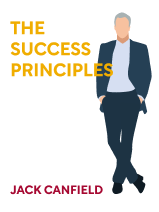

This article is an excerpt from the Shortform book guide to "The Success Principles" by Jack Canfield. Shortform has the world's best summaries and analyses of books you should be reading.
Like this article? Sign up for a free trial here .
What does your online presence say about you? Do you put a lot of thought into what you post online? What kind of image do you want to project?
Building an impactful personal online presence requires a lot of forethought. You need to think about what image you would like to project, what kind of audiences you want to attract, and what you want to accomplish.
In this article, you’ll learn four steps to cultivate a good personal online presence that aligns with your goals.
4 Steps to Build Your Online Presence
Successful people are hyperaware of how their personal online presence, or brand, affects their entrepreneurial or philanthropic endeavors. They actively cultivate a brand that frames them as an authority worth listening to.
Step 1: Develop Your Online Footprint
To create your personal online presence, it’s important to know what you want to do. Whether it’s starting a new business or leading volunteers in cleaning up a local beach, make a plan to get people to engage with you or align with your cause. You may also want to make yourself attractive to prospective employers. Do this by creating content that positions you or your company as credible, forward-thinking, and authoritative.
For example, if you aspire to become a C-level executive someday, creating a personal online presence or offering content that shows you’re forward-thinking and competent will make potential employers more confident in your abilities. Some executives also hire media relations personnel, write books, or accept speaking invitations to grow their presence in their field. People with a significant presence in their field are often perceived as bringing value to their employer.
Here are three tips to create and share content online.
Tip #1: Create a Website and Blog
A personal website and blog allow you to showcase your work, accomplishments, perspectives, and solutions. As you share stories and respond to comments, you can build confidence while growing your presence on the Internet. Google’s algorithm favors blogs, so having one is a way to drive traffic to your website.
Here are the steps to create your blog and website:
- Choose a platform. There are ample online platforms that make it easy to build a website and blog. Canfield recommends WordPress for blogs and websites.
- Build it yourself, or hire someone to do it. Consider including different pages, such as one that describes you and your work, one where people can purchase your products, and one to showcase work. If you’re uncertain about building a website or blog, hire someone to do it through a freelance site like Fiverr.
- Consider creating a phrase, buzzword, or brand name that people can associate with you and your work. Offering people a catchy phrase can help them search for and find your work online. For example, Canfield’s phrase for his book series was Chicken Soup for the Soul.
Tip #2: Identify Your Audience
After creating your blog or website, identify the people you want to reach by asking:
- Who are the people that are most interested in my insight, knowledge, and expertise?
- How are we related? It’s possible you work in or study the same field. Or they may be people you share interests or hobbies with.
Tip #3: Create Social Media Profiles
Social media profiles are a helpful way to share content that grows your online brand. They accomplish this in two ways:
- You share bite-sized pieces of information to engage readers and encourage them to read your blog or website where they purchase or access your services.
- You can network and connect with other professionals and people in or outside of your field.
LinkedIn and Facebook are the top two social media sites. LinkedIn is designed specifically as a professional network, whereas Facebook’s users include people who use it for personal use, business, or both. You’ll learn more about how to use these platforms later in this section.
Step 2: Create Content and Behave in a Way That Aligns With Your Brand
Once you’ve created your online footprint, create content and act in a way that aligns with your brand. Your online behavior affects how people perceive you and your work. When your behavior is trustworthy, people perceive you as someone worth listening to. But many people aren’t careful about how they act online—they may post comments, photos, or other information that paints an image out of alignment with their entrepreneurial or philanthropic efforts.
Follow these five tips to align your behavior with your brand:
1. Participate more, and aim to develop more meaningful relationships. When you sign up for an online profile, you have a new way to interact with people online. But it’s easy to browse conversations without interacting. To further your brand, be an active member of the online communities you’re part of. This could include commenting, answering people’s questions, and showing an interest in others.
Being active in online communities is a great way to form a team that supports you, as discussed in Part 4: Nurture Your Best Self. For example, you could learn about the work of potential mentors and strike up a conversation with them through an online forum, growing your personal support network.
2. Explain your motivation and share your passion. Telling people about your product or goal won’t necessarily draw in others to your mission—tell people why you do what you do. Sharing your passion and enthusiasm is one way to express this. For example, you may be able to gather a following by telling people you’re raising money to engineer an improved bicycle helmet. But if you share a personal story about your sister suffering a bike accident and severe brain injury, even though she was wearing a helmet, you help people understand why you’re motivated and passionate about engineering a better bicycle helmet, which can draw more people to support you.
3. Help others learn. At a basic level, a brand is a demonstration of what you’re good at. To show you’re good at something, strive to inform people, teach them something, or offer advice. It means showing more interest in people and their needs than sharing your message (though these often go hand-in-hand). Do this in most online interactions, such as comments, blog posts, or a post on social media.
For example, if you’re a personal coach, offer advice through your blog that demonstrates the service you provide.
4. Project positivity and share your success. There are many sarcastic or negative people online. Choose the path of positivity instead to stand out from the crowd. This means treating others with respect, kindness, and love and having an optimistic outlook about the world.
Also, share stories about how you became successful. Stories help people see you in a fuller light and show them how to chart their own path to success.
5. Give a TED Talk. Canfield recommends visualizing yourself giving a TED talk someday as a motivation to build your brand. TED talks are generally given by leaders in their field at TED conferences around the world; each talk runs for 18 minutes. Though videos of this length don’t tend to go viral like shorter clips, TED videos often do. The CEO and curator, Chris Anderson, thinks the following five techniques allow speakers to engage deeply with viewers:
- Using clear language, humor, and minimal jargon
- Sparking curiosity about the subject matter in the viewer
- Creating an emotional connection with viewers
- Focusing on substance rather than performance
- Avoiding manipulation of the viewer
Step 3: Use Social Media Effectively
Social media is a powerful tool to connect with colleagues, followers, and customers. As you create social media posts, you encourage people to engage with you and your brand, and share what they see with their friends and colleagues. LinkedIn and Facebook are two of the most popular social media platforms.
LinkedIn: Virtual Professional Networking
LinkedIn is best used to professionally connect with colleagues. Canfield offers four steps to begin with LinkedIn:
- Create your profile. Only include information that’s relevant to your current business endeavor. For example, it’s not relevant to share your experience becoming a certified yoga instructor 20 years ago if it’s drastically different from your current business.
- Expand your contacts. LinkedIn offers a feature in which it searches your contacts to connect you with those who already have profiles on the website. Connect with contacts in a variety of fields and businesses.
- Ask for endorsements. LinkedIn will prompt users to endorse their connections’ skills, such as public speaking, research, or using a certain computer programming language. These endorsements will then appear on your profile. Reach out to some of your connections to get four to five endorsements to start.
- Participate in groups and publish articles. Joining interest groups of people in your industry provides a chance to discuss topics and showcase your skills and knowledge. Posting articles does the same.
Facebook: Connect With Followers and Customers
Facebook is the largest social media site today, with 900 million users, so it’s the most valuable for you to learn. Canfield describes two tips for maximizing your success on Facebook.
Tip #1: Structure Your Posts to Attract and Retain Followers
Try the following ideas to create compelling posts that engage people and build a large base of followers:
- Use Facebook’s tools to share posts with specific users. Facebook’s features let you select the characteristics of the people you want your post to reach, such as age and relationship status. This can be used to target people you’d like to have as followers or a specific subset of people who already follow you.
- Write posts that link to your website. Social media allows you to share ideas, while linking to your website where people can get more information. For example, you can link to your website to encourage people to sign up for your email list.
- Only post content that furthers your brand. For example, Canfield has a friend who is an award-winning flower arranger, but she doesn’t post about it on her professional social media profiles because she’s an executive whose business has nothing to do with flower arranging—it’s just a hobby.
- Use photos and video. Using photos and video helps create an emotional connection. Your tone of voice in videos helps viewers relate to your enthusiasm and passion. The most effective images show people using your product or following your advice. Some text is fine, but Canfield recommends limiting it to 100-250 words.
- Offer exclusive news, information, products, discounts, events, and so on. Tell people to “Like” your page for this level of access. In addition, provide exclusive offers for people who already “Like” your page. This rewards people for their continued interest in your brand and can drive sales. For example, do a 10-day product giveaway to reward followers and generate interest and sales.
- Create posts that engage people in conversation. Posting a quote, a video of yourself, or asking people to share their ideas and feedback results in high engagement compared to posting an article link.
Tip #2: Develop a Posting Plan
Once you’ve decided what kind of content you’ll post, use these two tips to make a plan for when you’ll post:
- Create a posting calendar. Develop a schedule for when you’ll post content and what you’ll talk about. Experiment with a schedule that works best for your schedule and for tapping the interest of your followers. You can also write posts connected with holidays, current events, or other things relevant to your followers.
- Create and schedule posts ahead of time. Facebook has a feature that allows you to create posts in advance and schedule them for posting later. Canfield suggests creating a few posts at once and scheduling them for publication when your followers are online. Look at the insights page to find out when that is. (You can also use the insights page to see how your posts performed and adjust accordingly.)
Step 4: Clean Up Your Online Persona
Given the ease with which personal information ends up online, it’s possible that some negative information about you will circulate. For example, sometimes photos end up online that show questionable or unprofessional behavior. Or you may have experienced a falling out with a business partner that leaves a digital trail. Services that specialize in cleaning up and managing people’s online reputations can help you cultivate the image you want, but Canfield offers steps you can take on your own, too.
Search Cleanup: A Privacy Option for Europeans
The European Union’s Court of Justice requires that Google allow people to petition for the removal of information about them from searches that is “inadequate, irrelevant, or excessive.” This “right to be forgotten” is designed to help prevent damaging information about an individual from circulating online forever. On the first day it was in operation, 12,000 people submitted petitions. Though the law is only in effect in Europe, it can be worth checking on whether this service is available where you live.
Exercise: Assess Your Social Media Use
Reflect on your professional social media habits.
Do you use social media to advance your professional brand? Why or why not?
In Step 3 of the previous section, Canfield offers tips for effective social media use. List one or two recommendations that could be most useful to you and briefly describe how they could advance your career.

———End of Preview———
Like what you just read? Read the rest of the world's best book summary and analysis of Jack Canfield's "The Success Principles" at Shortform .
Here's what you'll find in our full The Success Principles summary :
- The 67 principles to help anyone achieve their goals and dreams
- Why achieving your goals requires you to invest your time and effort
- How to take responsibility for your own life






